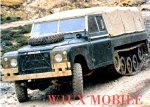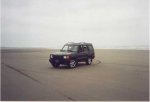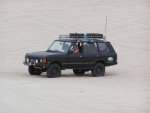scrover said:Air down below 15 psi. - the lower the better.
Wider tires don't help - they'll just push a larger pile of sand in front of your tire. Most of the classic sand tires (Michelin XS, Pirelli Scorpion Dakar etc.) are 7.50R16 - narrower than any current stock Land Rover tire. They work in the Sahara desert - they'll work for you.
Taller tires aired down will keep your axles out of the sand and minimize your rolling resistance. You want to lengthen your foot-print, not widen it. A mild tread helps.
Not just MHO
SC
I agree with everything in this thread but ... the above quote. It actually contradicts itself.
What reducing the air pressure in the tires does IS make your tire wider. How can you say air down the tires and then say wider tires don't help? I can't help but ask that question. That dog just don't hunt!
The sand tires you quote are used on rally cars weighing less than half that of a Disco and traveling 3 times the speed. Ever see what happens to one of those babies if they slow down in the sand? They sink! Right down to the frame.
Agree taller tires keep the axel out of the sand, but how do taller tires minimize rolling resistance? Or do you mean narrower tires reduce rolling resistance. The whole pushing sand with wider tires only means your speed is too slow. Maintain the speed/momentum to stay ON TOP of the sand.
The keys to driving on the sand, and these worked for me driving the Disco from Dubai-UAE to Jeddah-KSA, to Amman-Jordon and back to Dubai (get out your maps if necessary):
Air the tires down to safely above bead loss
Lock the diff and leave it there
Starts and stops are made slowly in middle/low gears
KNOW where you are going ... look ahead at least 1/4 mile
Maintain your speed and the momentum or start digging
Use Low range only when "getting out"
Bring the proper recovery equipment
Tires: the best are those with tread patterns that cross the tire left to right, not front to back (I know these are much louder...on the street). My favorites are Mickey Thompsons for their tread pattern which continues to the side wall (which is great when aired down).
Of course, you as the driver make the final call for your rig. These are just my opinions and really don't mean anything (unless RoverChic finds them impressive and will go out with me
SandMan




